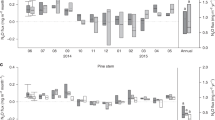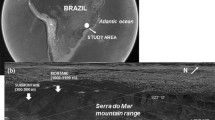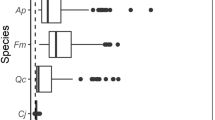Abstract
The 13C isotopic signature (C stable isotope ratio; δ13C) of CO2 respired from forest ecosystems and their particular compartments are known to be influenced by temporal changes in environmental conditions affecting C isotope fractionation during photosynthesis. Whereas most studies have assessed temporal variation in δ13C of ecosystem-respired CO2 on a day-to-day scale, not much information is available on its diel dynamics. We investigated environmental and physiological controls over potential temporal changes in δ13C of respired CO2 by following the short-term dynamics of the 13C signature from newly assimilated organic matter pools in the needles, via phloem-transported organic matter in twigs and trunks, to trunk-, soil- and ecosystem-respired CO2. We found a strong 24-h periodicity in δ13C of organic matter in leaf and twig phloem sap, which was strongly dampened as carbohydrates were transported down the trunk. Periodicity reappeared in the δ13C of trunk-respired CO2, which seemed to originate from apparent respiratory fractionation rather than from changes in δ13C of the organic substrate. The diel patterns of δ13C in soil-respired CO2 are partly explained by soil temperature and moisture and are probably due to changes in the relative contribution of heterotrophic and autotrophic CO2 fluxes to total soil efflux in response to environmental conditions. Our study shows that direct relations between δ13C of recent assimilates and respired CO2 may not be present on a diel time scale, and other factors lead to short-term variations in δ13C of ecosystem-emitted CO2. On the one hand, these variations complicate ecosystem CO2 flux partitioning, but on the other hand they provide new insights into metabolic processes underlying respiratory CO2 emission.






Similar content being viewed by others
References
Atkin OK, Edwards EJ, Loveys BR (2000) Response of root respiration to changes in temperature and its relevance to global warming. New Phytol 147:141–154
Badeck FW, Tcherkez G, Nogues S, Piel C, Ghashghaie J (2005) Post-photosynthetic fractionation of stable carbon isotopes between plant organs—a widespread phenomenon. Rapid Commun Mass Spectrom 19:1381–1391
Barnard RL, Salmon Y, Kodama N, Sörgel K, Holst J, Rennenberg H, Gessler A, Buchmann N (2007) Evaporative enrichment and time lags between δ18O of leaf water and organic pools in a pine stand. Plant Cell Environ 30:539–550
Beadle CL, Neilson RE, Talbot H, Jarvis PG (1985) Stomatal conductance and photosynthesis in a mature Scots pine forest. 1. Diurnal, seasonal and spatial variations in shoots. J Appl Ecol 22:557–571
Berry JA, Raison JK (1981) Responses of macrophytes to temperature. In: Lange OL, Nobel PS, Osmond B, Ziegler H (eds) Physiological plant ecology. I. Responses to the physical environment. Springer, Berlin, pp 277–338
Betson NR, Göttlicher SG, Hall M, Wallin G, Richter A, Högberg P (2007) No diurnal variation in rate or carbon isotope composition of soil respiration in a boreal forest. Tree Physiol 27:749–756
Bhupinderpal S, Nordgren A, Lofvenius MO, Högberg MN, Mellander PE, Hogberg P (2003) Tree root and soil heterotrophic respiration as revealed by girdling of boreal Scots pine forest: extending observations beyond the first year. Plant Cell Environ 26:1287–1296
Boone RD, Nadelhoffer KJ, Canary JD, Kaye JP (1998) Roots exert a strong influence on the temperature sensitivity of soil respiration. Nature 396:570–572
Bowling DR, Tans PP, Monson RK (2001) Partitioning net ecosystem carbon exchange with isotopic fluxes of CO2. Global Change Biol 7:127–145
Bowling DR, McDowell NG, Bond BJ, Law BE, Ehleringer JR (2002) 13C content of ecosystem respiration is linked to precipitation and vapor pressure deficit. Oecologia 131:113–124
Bowling DR, Sargent SD, Tanner BD, Ehleringer JR (2003) Tunable diode laser absorption spectroscopy for stable isotope studies of ecosystem-atmosphere CO2 exchange. Agric For Meteorol 118:1–19
Brandes E, Kodama N, Whittaker K, Weston C, Rennenberg H, Keitel C, Adams MA, Gessler A (2006) Short-term variation in the isotopic composition of organic matter allocated from the leaves to the stem of Pinus sylvestris: effects of photosynthetic and postphotosynthetic carbon isotope fractionation. Global Change Biol 12:1922–1939
Brandes E, Wenninger J, Koeniger P, Schindler D, Rennenberg H, Leibundgut C, Mayer H, Gessler A (2007) Assessing environmental and physiological controls over water relations in a Scots pine (Pinus sylvestris L.) stand through analyses of stable isotope composition of water and organic matter. Plant Cell Environ 30:113–127
Carbone MS, Trumbore SE (2007) Contribution of new photosynthetic assimilates to respiration by perennial grasses and shrubs: residence times and allocation patterns. New Phytol 176:124–135
Cernusak LA, Farquhar GD, Pate JS (2005) Environmental and physiological controls over oxygen and carbon isotope composition of Tasmanian blue gum, Eucalyptus globulus. Tree Physiol 25:129–146
Damesin C, Lelarge C (2003) Carbon isotope composition of current-year shoots from Fagus sylvatica in relation to growth, respiration and use of reserves. Plant Cell Environ 26:207–219
Damesin C, Barbaroux C, Berveiller D, Lelarge C, Chaves M, Maguas C, Maia R, Pontailler JY (2005) The carbon isotope composition of CO2 respired by trunks: comparison of four sampling methods. Rapid Commun Mass Spectrom 19:369–374
Ekblad A, Högberg P (2000) Analysis of δ13C of CO2 distinguishes between microbial respiration of added C4-sucrose and other soil respiration in a C3-ecosystem. Plant Soil 219:197–209
Ekblad A, Högberg P (2001) Natural abundance of 13C in CO2 respired from forest soils reveals speed of link between tree photosynthesis and root respiration. Oecologia 127:305–308
Ekblad A, Boström B, Holm A, Comstedt D (2005) Forest soil respiration rate and δ13C is regulated by recent above ground weather conditions. Oecologia 143:136–142
Farquhar GD, O’Leary MH, Berry JA (1982) On the relationship between carbon isotope discrimination and the inter-cellular carbon-dioxide concentration in leaves. Aust J Plant Physiol 9:121–137
Fischer C, Holl W (1991) Food reserves of Scots pine (Pinus sylvestris L.). 1. Seasonal changes in the carbohydrate and fat reserves of pine needles. Trees Struc Funct 5:187–195
Gessler A, Kreuzwieser J, Dopatka T, Rennenberg H (2002) Diurnal courses of ammonium net uptake by the roots of adult beech (Fagus sylvatica) and spruce (Picea abies) trees. Plant Soil 240:23–32
Gessler A, Rennenberg H, Keitel C (2004) Stable isotope composition of organic compounds transported in the phloem of European beech—evaluation of different methods of phloem sap collection and assessment of gradients in carbon isotope composition during leaf-to-stem transport. Plant Biol 6:721–729
Gessler A, Keitel C, Kodama N, Weston C, Winters AJ, Keith H, Grice K, Leuning R, Farquhar GD (2007a) δ13C of organic matter transported from the leaves to the roots in Eucalyptus delegatensis: short-term variations and relation to respired CO2. Funct Plant Biol 34:692–706
Gessler A, Peuke AD, Keitel C, Farquhar GD (2007b) Oxygen isotope enrichment of organic matter in Ricinus communis during the diel course and as affected by assimilate transport. New Phytol 174:600–613
Ghashghaie J, Duranceau M, Badeck FW, Cornic G, Adeline MT, Deléens E (2001) δ13C of CO2 respired in the dark in relation to δ13C of leaf metabolites: comparison between Nicotiana sylvestris and Helianthus annuus under drought. Plant Cell Environ 24:505–515
Ghashghaie J, Badeck FW, Lanigan G, Nogués S, Tcherkez G, Deléens E, Cornic G, Griffiths H. (2003) Carbon isotope discrimination during dark respiration and photorespiration in C3 plants. Phytochem Rev 2:145–161
Gleixner G, Schmidt HL (1997) Carbon isotope effects on the fructose-1,6-bisphosphate aldolase reaction, origin for non-statistical 13C distributions in carbohydrates. J Biol Chem 272:5382–5387
Göttlicher S, Knohl A, Wanek W, Buchmann N, Richter A (2006) Short-term changes in carbon isotope composition of soluble carbohydrates and starch: from canopy leaves to the root system. Rapid Commun Mass Spectrom 20:653–660
Granier A (1985) A new method of sap flow measurement in tree stems. Ann Sci For 42:193–200
Granier A (1987) Evaluation of transpiration in a Douglas-fir stand by means of sap flow measurements. Tree Physiol 3:309–319
Granier A, Biron P, Breda N, Pontailler JY, Saugier B (1996) Transpiration of trees and forest stands: Short and longterm monitoring using sapflow methods. Global Change Biol 2:265–274
Heinemeyer A, Hartley IP, Evans SP, De la Fuente JAC, Ineson P (2007) Forest soil CO2 flux: uncovering the contribution and environmental responses of ectomycorrhizas. Global Change Biol 13:1786–1797
Högberg P, Nordgren A, Buchmann N, Taylor AFS, Ekblad A, Högberg MN, Nyberg G, Ottosson-Lofvenius M, Read DJ (2001) Large-scale forest girdling shows that current photosynthesis drives soil respiration. Nature 411:789–792
Hymus GJ, Maseyk K, Valentini R, Yakir D (2005) Large daily variation in 13C-enrichment of leaf-respired CO2 in two Quercus forest canopies. New Phytol 167:377–384
IPCC (2007) Climate change 2007—The physical science basis. Contribution of working Group I to the fourth assessment report of the intergovernmental panel on climate change. Cambridge University Press, Cambridge, 996
Johnsen K, Maier C, Sanchez F, Anderson P, Butnor J, Waring R, Linder S (2007) Physiological girdling of pine trees via phloem chilling: proof of concept. Plant Cell Environ 30:128–134
Keeling CD (1958) The concentration and isotopic abundances of atmospheric carbon dioxide in rural areas. Geochim Cosmochim Acta 13:322–334
Keeling CD (1961) The concentration and isotopic abundances of carbon dioxide in rural and marine air. Geochim Cosmochim Acta 24:277–298
Keitel C, Adams MA, Holst T, Matzarakis A, Mayer H, Rennenberg H, Gessler A (2003) Carbon and oxygen isotope composition of organic compounds in the phloem sap provides a short-term measure for stomatal conductance of European beech (Fagus sylvatica L.). Plant Cell Environ 26:1157–1168
Keitel C, Matzarakis A, Rennenberg H, Gessler A (2006) Carbon isotope composition and oxygen isotope enrichment in phloem and total leaf organic matter of European beech (Fagus sylvatica L.) along a climate gradient. Plant Cell Environ 29:1492–1507
Kendall SM, Ord JK (2006) Time series. Oxford University Press, New York
Knohl A, Buchmann N (2005) Partitioning the net CO2 flux of a deciduous forest into respiration and assimilation using stable carbon isotopes. Global Biogeochem Cycles 19
Knohl A, Werner RA, Brand WA, Buchmann N (2005) Short-term variations in δ13C of ecosystem respiration reveals link between assimilation and respiration in a deciduous forest. Oecologia 142:70–82
Lancaster J (1990) 13C fractionation in carbon dioxide emitting diurnally from soils and vegetation at ten sites on the North American continent. PhD Thesis, University of California, San Diego
Luoma S (1997) Geographical pattern in photosynthetic light response of Pinus sylvestris in Europe. Funct Ecol 11:273–281
Maunoury F, Berveiller D, Lelarge C, Pontailler JY, Vanbostal L, Damesin C (2007) Seasonal, daily and diurnal variations in the stable carbon isotope composition of carbon dioxide respired by tree trunks in a deciduous oak forest. Oecologia 151:268–279
Mayer H, Jaeger L, Matzarakis A, Fernbach G, Redepenning D (2000) Forstmeteorologische Messstelle Hartheim des Meteorologischen Instituts der Universität Freiburg. Ber Meteorol Inst Univ Freiburg 5:55–83
Mortazavi B, Chanton JP, Prater JL, Oishi AC, Oren R, Katul G (2005) Temporal variability in 13C of respired CO2 in a pine and a hardwood forest subject to similar climatic conditions. Oecologia 142:57–69
Nabuurs GJ, Schelhaas MJ, Mohren GMJ, Field CB (2003) Temporal evolution of the European forest sector carbon sink from 1950 to 1999. Global Change Biol 9:152–160
Ogée J, Peylin P, Ciais P, Bariac T, Brunet Y, Berbigier P, Roche C, Richard P, Bardoux G, Bonnefond JM (2003) Partitioning net ecosystem carbon exchange into net assimilation and respiration using 13CO2 measurements: a cost-effective sampling strategy. Global Biogeochem Cycles 17
Ogée J, Peylin P, Cuntz M, Bariac T, Brunet Y, Berbigier P, Richard P, Ciais P (2004) Partitioning net ecosystem carbon exchange into net assimilation and respiration with canopy-scale isotopic measurements: an error propagation analysis with 13CO2 and CO18O data. Global Biogeochem Cycles 18:GB2019
Pataki DE, Ehleringer JR, Flanagan LB, Yakir D, Bowling DR, Still CJ, Buchmann N, Kaplan JO, Berry JA (2003) The application and interpretation of Keeling plots in terrestrial carbon cycle research. Global Biogeochem Cycles 17
Prater JL, Mortazavi B, Chanton JP (2006) Diurnal variation of the δ13C of pine needle respired CO2 evolved in darkness. Plant Cell Environ 29:202–211
Rossmann A, Butzenlechner M, Schmidt HL (1991) Evidence for a nonstatistical carbon isotope distribution in natural glucose. Plant Physiol 96:609–614
Saxe H, Ellsworth DS, Heath J (1998) Tree and forest functioning in an enriched CO2 atmosphere. New Phytol 139:395–436
Scartazza A, Mata C, Matteucci G, Yakir D, Moscatello S, Brugnoli E (2004) Comparisons of delta C-13 of photosynthetic products and ecosystem respiratory CO2 and their response to seasonal climate variability. Oecologia 140:340–351
Schneider S, Gessler A, Weber P, von Sengbusch D, Hanemann U, Rennenberg H (1996) Soluble N compounds in trees exposed to high loads of N: a comparison of spruce (Picea abies) and beech (Fagus sylvatica) grown under field conditions. New Phytol 134:103–114
Stoy PC, Palmroth S, Oishi AC, Siqueira MBS, Juang J-Y, Novick KA, Ward EJ, Katul GG, Oren R (2007). Are ecosystem carbon inputs and outputs coupled at short time scales? A case study from adjacent pine and hardwood forests using impulse-response analysis. Plant Cell Environ 30:700–710
Tcherkez G, Nogués S, Bleton J, Cornic G, Badeck F, Ghashghaie J (2003) Metabolic origin of carbon isotope composition of leaf dark-respired CO2 in French bean. Plant Physiol 131:237–244
Tcherkez G, Farquhar G, Badeck F, Ghashghaie J (2004) Theoretical considerations about carbon isotope distribution in glucose of C3 plants. Funct Plant Biol 31:857–877
Teskey RO, McGuire MA (2005) CO2 transported in xylem sap affects CO2 efflux from Liquidambar styraciflua and Platanus occidentalis stems, and contributes to observed wound respiration phenomena. Trees Struct Funct 19:357–362
Teskey RO, Saveyn A, Steppe K, McGuire MA (2008) Origin, fate and significance of CO2 in tree stems. New Phytol 177:17–32
Theis DE, Saurer M, Blum H, Frossard E, Siegwolf RTW (2004) A portable automated system for trace gas sampling in the field and stable isotope analysis in the laboratory. Rapid Commun Mass Spectrom 18:2106–2112
von Caemmerer S, Farquhar GD (1981) Some relationships between the biochemistry of photosynthesis and the gas-exchange of leaves. Planta 153:376–387
Werner C, Unger S, Pereira JS, Maia R, David TS, Kurz-Besson C, David JS, Maguas C (2006) Importance of short-term dynamics in carbon isotope ratios of ecosystem respiration (δ13CR) in a Mediterranean oak woodland and linkage to environmental factors. New Phytol 172:330–346
Werner C, Hasenbein N, Maia R, Beyschlag W, Maguas C (2007) Evaluating high time-resolved changes in carbon isotope ratio of respired CO2 by a rapid in-tube incubation technique. Rapid Commun Mass Spectrom 21:1352–1360
Yakir D, Wang XF (1996) Fluxes of CO2 and water between terrestrial vegetation and the atmosphere estimated from isotope measurements. Nature 380:515–517
Zobitz JM, Keener JP, Schnyder H, Bowling DR (2006) Sensitivity analysis and quantification of uncertainty for isotopic mixing relationships in carbon cycle research. Agric For Meteorol 136:56–75
Acknowledgements
We thank Eva Hilbig, Elke Brandes and Zhao Ping for their help in the field. Y. S. was supported by the Swiss National Fund for Research (project 629 n 3100A0-105273/1). A. G. acknowledges personal financial support by a research fellowship from the Deutsche Forschungsgemeinschaft (GE 1090/4-1). Part of this study was financially supported by the European Union (INTERREG III A, project 3c.10). J. P. F. is grant-aided by a Marie Curie Intra-European Fellowship (6th Framework Programme, EU). We declare that the experiments comply with the current laws of the country in which they were performed.
Author information
Authors and Affiliations
Corresponding author
Additional information
Communicated by Andrea Polle.
Rights and permissions
About this article
Cite this article
Kodama, N., Barnard, R.L., Salmon, Y. et al. Temporal dynamics of the carbon isotope composition in a Pinus sylvestris stand: from newly assimilated organic carbon to respired carbon dioxide. Oecologia 156, 737–750 (2008). https://doi.org/10.1007/s00442-008-1030-1
Received:
Accepted:
Published:
Issue Date:
DOI: https://doi.org/10.1007/s00442-008-1030-1




